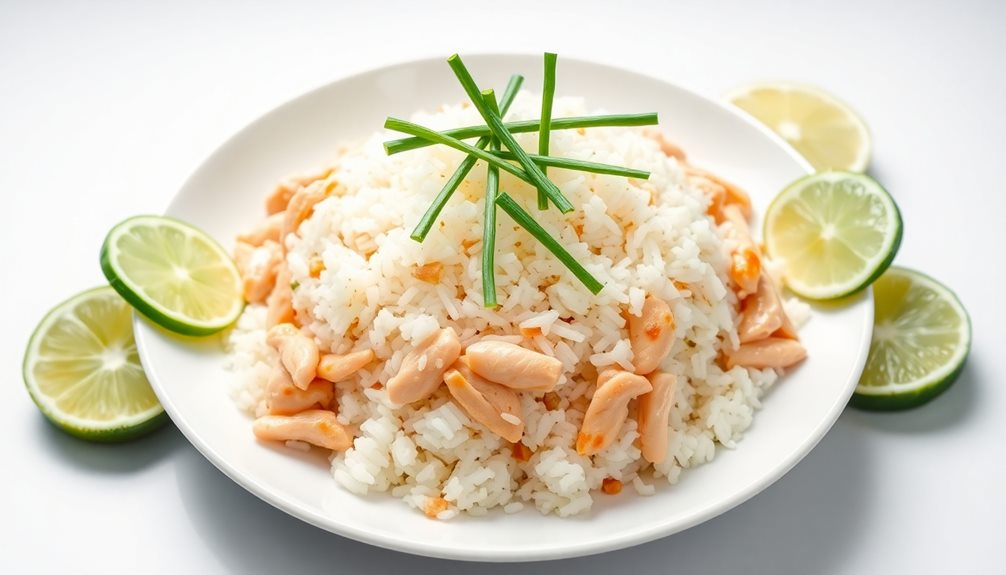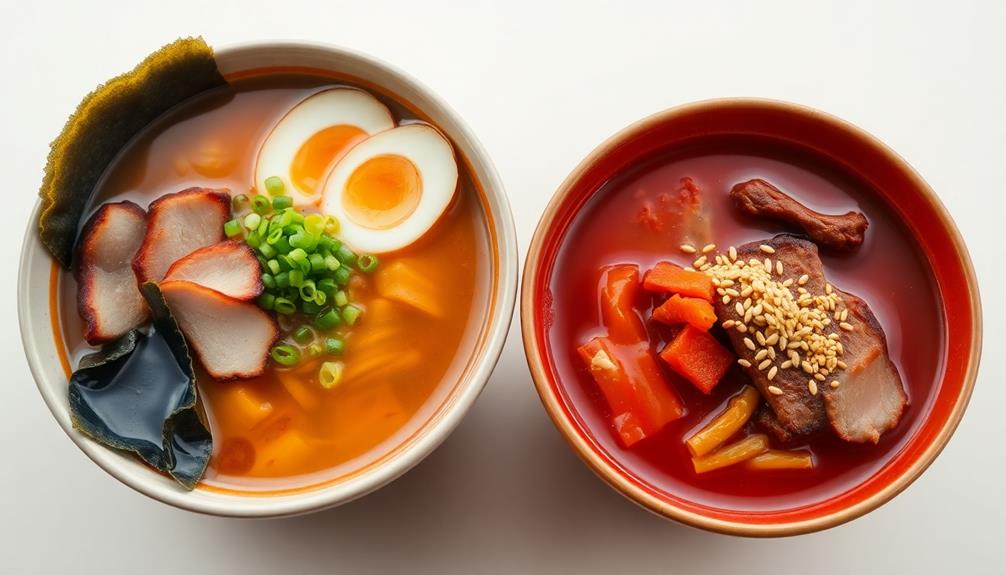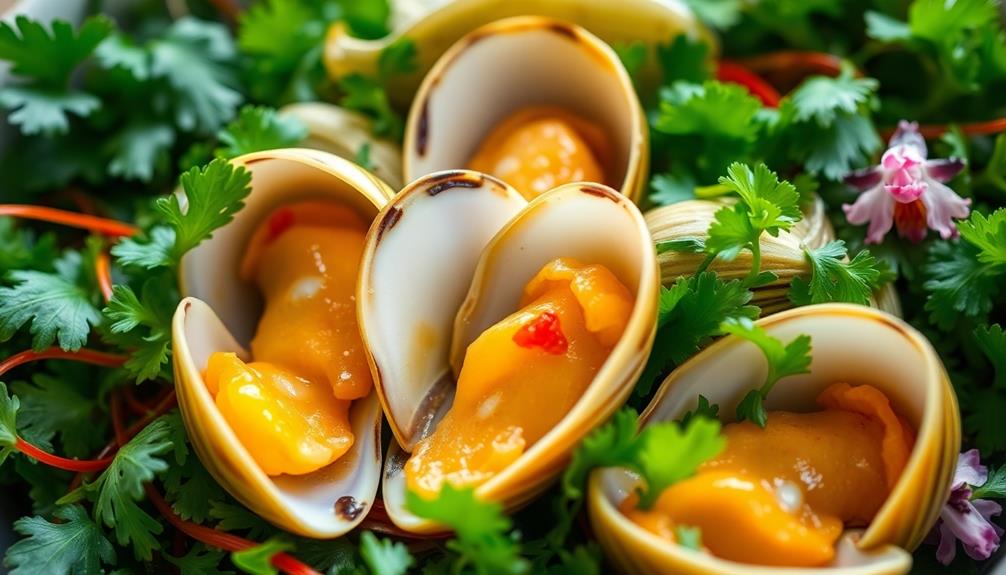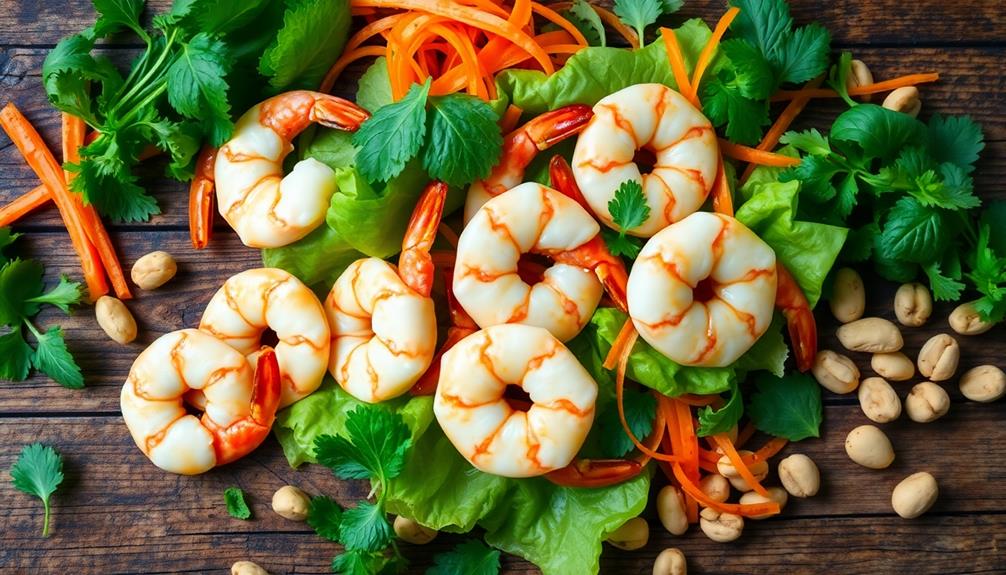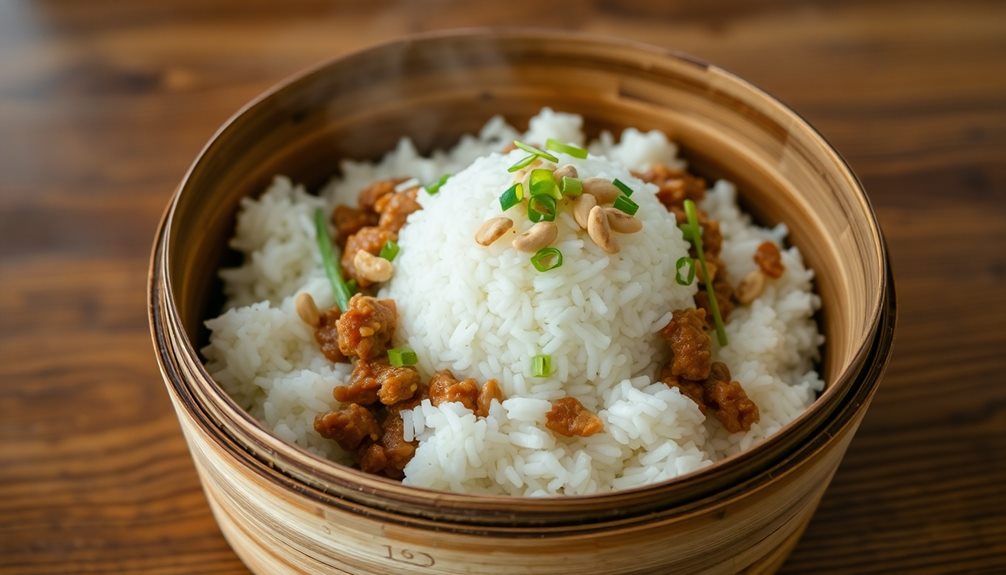Cơm Gà, the Vietnamese chicken rice dish, is a must-try culinary delight! Its origins trace back to Southeast Asia, with a unique twist from Vietnamese cooks. The key ingredients – poached chicken, fragrant rice, and fresh herbs – create a harmonious blend of flavors and textures. Start by rinsing the chicken, then marinate it in a savory mix of lemongrass, ginger, and spices. Simmer the chicken until tender, then fluff the rice and assemble the dish. Enjoy this beloved national dish of Vietnam, and get ready to discover even more about its captivating history and authentic preparation.
Key Takeaways
Key points:
- Originated from traditional Southeast Asian culinary influences, incorporating Chinese and Malay cuisines.
- Unique Vietnamese touch enhances the fragrance and flavor, making it a beloved national dish.
- Comprises poached chicken and fragrant rice, creating a distinct and harmonious taste.
- Precise cooking techniques, such as marinating the chicken and fluffing the rice, are crucial for authenticity.
- Easy to prepare at home, allowing home cooks to enjoy the authentic flavors of this Vietnamese specialty.
History

The origins of the Vietnamese chicken rice dish can be traced back to the culinary traditions of Southeast Asia. It's believed that this beloved dish evolved from the rice and chicken staples of the region, blending Chinese and Malay influences.
Over time, Vietnamese cooks added their own unique twist, creating the fragrant and flavorful dish we know today. They incorporated local ingredients such as fresh herbs, star anise, and fish sauce, infusing the dish with vibrant, aromatic depth. One common accompaniment is traditional Vietnamese giò lụa, a silky, savory pork sausage wrapped in banana leaves that provides a subtle contrast to the robust flavors of the main dish. Together, these elements create a harmonious balance that showcases the ingenuity of Vietnamese cuisine.
The key to the dish's distinctive taste lies in the careful balance of ingredients. Tender chicken is poached in a broth infused with aromatic spices, then served over fluffy, fragrant rice.
The rice absorbs the rich, savory flavors, while the chicken remains moist and juicy. Garnishes like sliced cucumber, fresh herbs, and a tangy dipping sauce complete the dish, creating a harmonious symphony of textures and tastes.
What started as a humble peasant meal has now become a beloved national dish, enjoyed by people from all walks of life in Vietnam.
The enduring popularity of this chicken rice dish is a testament to the ingenuity and culinary prowess of the Vietnamese people.
Cooking Steps

Preparing the Vietnamese chicken rice dish is a straightforward process. First, you'll need to gather your ingredients – tender chicken, fragrant jasmine rice, aromatic herbs, and vibrant vegetables.
Start by simmering the chicken in a flavorful broth until it's cooked through and falling off the bone. Then, use the same broth to cook the rice, infusing it with rich, savory notes.
While the rice is cooking, chop up your vegetables – crisp lettuce, juicy tomatoes, and crunchy cucumbers. Tear the fresh herbs, like Vietnamese mint and cilantro, to release their bold, refreshing flavors.
When the rice is fluffy and the chicken is tender, it's time to assemble your dish. Scoop the rice into a bowl, top it with the shredded chicken, and arrange the colorful vegetables and herbs around the edges.
Step 1. Rinse Chicken Thoroughly in Water

Before you begin cooking the chicken, it's important to ensure it's thoroughly rinsed under cool running water. This step helps remove any dirt, debris, or bacteria that may be on the surface of the meat. Carefully inspect each piece, paying close attention to the nooks and crannies, to make sure it's completely clean.
Once the chicken is rinsed, you'll want to pat it dry with some paper towels. This will help the meat brown and crisp up nicely when you cook it.
It's also a good idea to give the cutting board a quick rinse and wipe down before placing the chicken on it. This helps prevent the spread of any lingering germs.
With the chicken prepped and ready to go, you can move on to the next step in the cooking process. Get excited, because the amazing flavors of this Vietnamese dish are about to come to life!
Step 2. Marinate Chicken in Spices
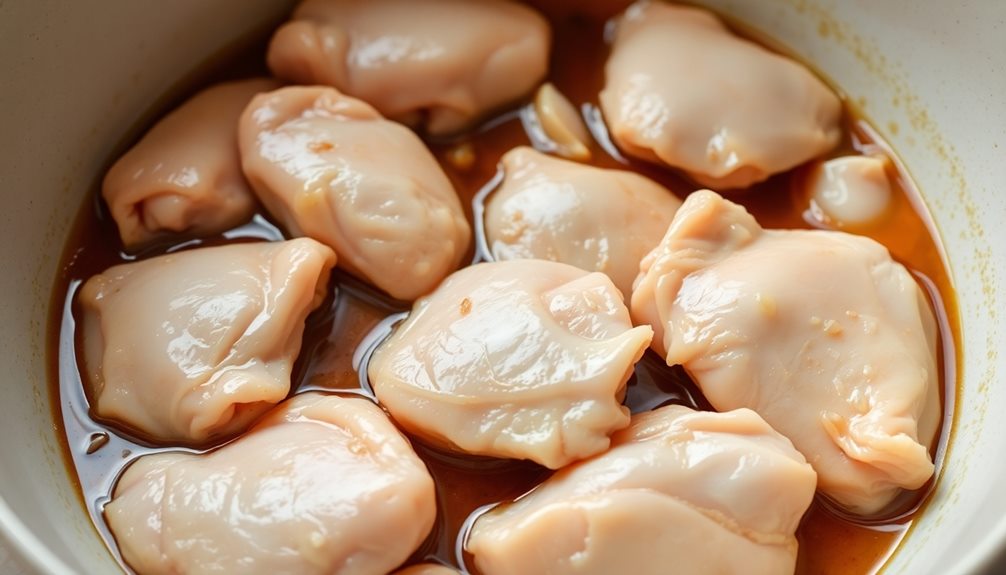
With the chicken prepped and ready, let's move on to marinating it in a flavorful blend of spices. In a large bowl, combine the chicken with some fragrant lemongrass, freshly grated ginger, and a pinch of ground turmeric.
These aromatic ingredients will infuse the meat with a delightful aroma and vibrant color. Next, drizzle in a few tablespoons of fish sauce and a touch of brown sugar. The fish sauce will lend a savory umami note, while the sugar will help balance the flavors and create a nice caramelized crust when the chicken is cooked.
Use your hands to gently massage the spices into the chicken, ensuring every nook and cranny is coated. Cover the bowl and let the chicken marinate in the fridge for at least 30 minutes, or up to 4 hours if you have the time.
This allows the flavors to really penetrate the meat, making it even more delectable.
Step 3. Bring Chicken and Marinade to Boil
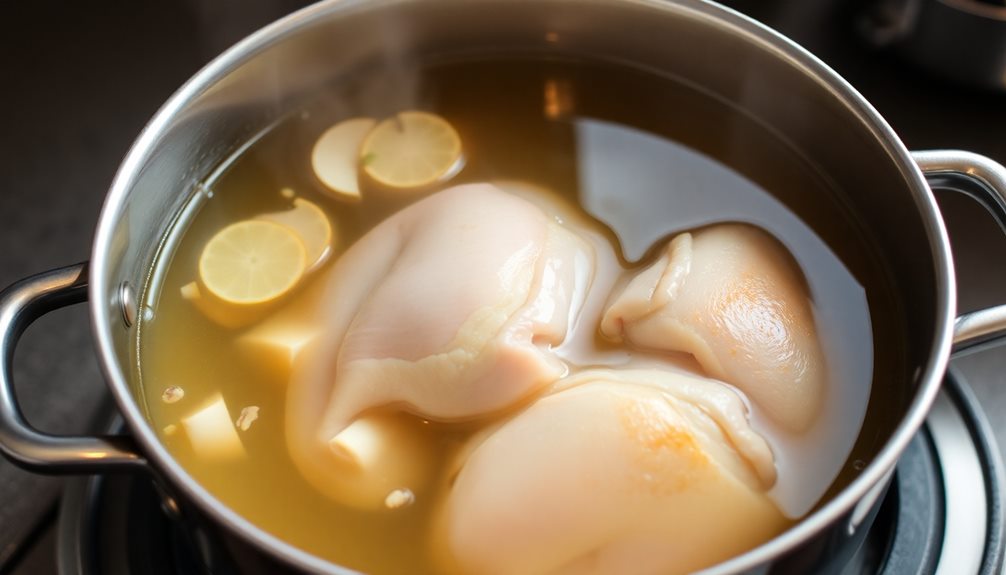
Now that the chicken has had a chance to soak up all those lovely flavors, it's time to get cooking. Grab the marinated chicken and add it to a large pot. Pour in the marinade, making sure the chicken is completely submerged.
Bring the mixture to a boil over medium-high heat. Once it reaches a rolling boil, reduce the heat to low and let it simmer for about 20 minutes. This will allow the chicken to cook through and the flavors to meld together.
As the chicken simmers, you'll notice the liquid starting to reduce and thicken. This is exactly what you want! The sauce will become rich and aromatic, infusing the chicken with an incredible depth of flavor.
Be sure to stir the pot occasionally to prevent any sticking or burning.
When the chicken is cooked through and the sauce has thickened to your liking, you're ready for the next step. Carefully remove the chicken from the pot and set it aside.
Get ready to assemble your delicious Vietnamese chicken rice dish!
Step 4. Cook Chicken Until Tender

Once the chicken has finished simmering, it's time to ensure it's cooked through and tender.
You'll want to use a pair of tongs or a fork to gently remove the chicken from the pot. Be careful, as the chicken will be hot! Transfer the chicken to a cutting board and let it rest for a few minutes. This resting period allows the juices to redistribute throughout the meat, making it even more tender and flavorful.
Now, take a sharp knife and start slicing the chicken into bite-sized pieces. You can slice it crosswise or lengthwise, whatever you prefer.
As you slice, keep an eye out for any signs that the chicken isn't fully cooked, like pinkish-red areas. If you spot any, simply return the chicken to the pot and let it simmer a little longer until it's completely white all the way through.
Once the chicken is nicely sliced and cooked to perfection, it's ready to be added to your Cơm Gà dish.
Get ready to enjoy the delicious flavors of this Vietnamese classic!
Step 5. Fluff Rice With Fork
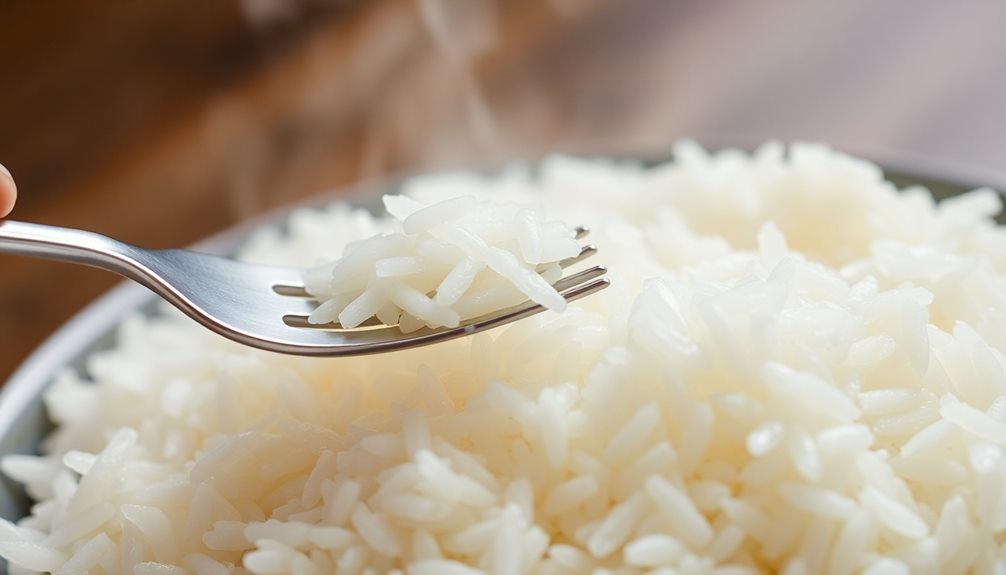
After the chicken has been cooked and sliced, you'll want to fluff the rice with a fork. This step is crucial for achieving the perfect texture.
Simply take a fork and gently run it through the cooked rice, separating the grains and creating a light, fluffy mound. Be careful not to overmix or press down on the rice, as this can make it sticky and clumpy.
The key is to use a gentle, lifting motion, allowing the rice to aerate and become light and airy. This will create the ideal base for your delicious Vietnamese chicken rice dish.
Once the rice is perfectly fluffed, you can begin assembling your meal, layering the tender, flavorful chicken on top and adding any desired garnishes or sauces.
The combination of the soft, fluffy rice and the juicy, seasoned chicken is simply divine. Get ready to enjoy a truly authentic taste of Vietnam!
Final Thoughts
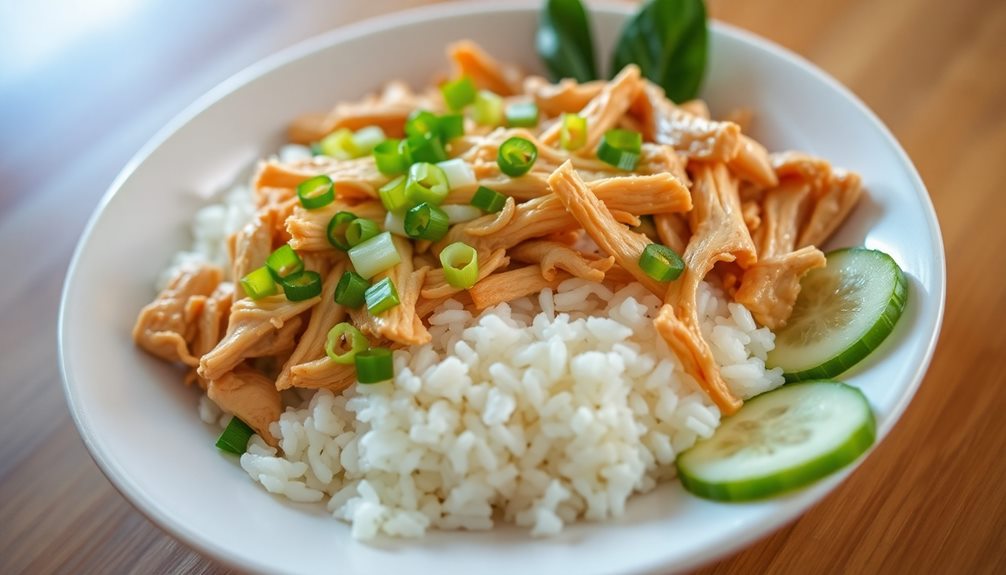
As you've explored the flavors and techniques of this delightful Vietnamese chicken rice dish, you may find yourself eager to recreate it in your own kitchen. The final thoughts are clear – this is a dish worth savoring and sharing.
The fragrant rice, the tender chicken, and the vibrant array of toppings come together in a symphony of taste and texture that will transport you to the bustling streets of Vietnam.
With a little practice, you'll be able to master the art of fluffing the rice and preparing the perfectly cooked chicken. The best part? This dish is surprisingly easy to make at home, allowing you to enjoy the authentic flavors whenever the craving strikes.
So, gather your ingredients, fire up the stove, and get ready to impress your friends and family with your culinary prowess.
Cơm gà, the Vietnamese chicken rice dish, is a true delight that deserves a permanent place in your recipe repertoire.
Frequently Asked Questions
What Is the Origin of the Name "CơM Gà"?
You'll find that the name "cơm gà" originates from the Vietnamese language, where "cơm" means "rice" and "gà" means "chicken," reflecting the dish's key ingredients of steamed rice and chicken.
How Long Does It Typically Take to Prepare CơM Gà?
Preparing cơm gà typically takes around an hour. You'll need to simmer the chicken, cook the rice, and assemble the dish with the garnishes. With some practice, you'll get the timing down and have a delicious meal in no time.
What Are the Common Variations of the CơM Gà Recipe?
The common variations of the cơm gà recipe include using different cuts of chicken, adding additional vegetables like cabbage or carrots, and experimenting with the seasoning and cooking methods to suit your personal taste preferences.
Can CơM Gà Be Served at Any Time of the Day?
Yes, you can enjoy cơm gà at any time of the day. It's a versatile dish that works well for breakfast, lunch, or dinner, depending on your preference and appetite.
Is CơM Gà a Healthy Dish to Incorporate Into a Diet?
Yes, cơm gà can be a healthy addition to your diet. It's a nutrient-dense meal that provides protein, carbohydrates, and essential vitamins and minerals. However, be mindful of portion sizes and how it's prepared to maintain a balanced, healthy intake.
